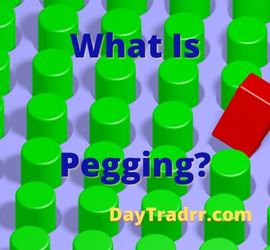What Is Pegging?
 What is pegging? In economics, pegging is the act of linking the value of an asset or currency to the value of another asset or currency establishing a fixed exchange rate. In general, the term refers to the practice of attaching or tying a country’s currency exchange rate to another country’s currency. Fixed-rate pegging involves using preset ratios. The practice is often used by central banks to provide stability to a nation’s currency by linking it to a more stable currency.
What is pegging? In economics, pegging is the act of linking the value of an asset or currency to the value of another asset or currency establishing a fixed exchange rate. In general, the term refers to the practice of attaching or tying a country’s currency exchange rate to another country’s currency. Fixed-rate pegging involves using preset ratios. The practice is often used by central banks to provide stability to a nation’s currency by linking it to a more stable currency.
The United States dollar is regarded as the world’s reserve currency. As a result, several countries utilize the dollar as a currency peg. However, pegging has applications beyond linking currencies. For example, the concept is applied to options trading and cryptocurrencies. The objective is to establish a fixed exchange rate for a stable, secure asset. In turn, this reduces volatility and offers stability to the linking asset. Commodities with reasonably constant pricing can help to stabilize an asset that is suffering too much volatility.
What is Pegging a Currency?
Wide currency movements may be very damaging to international commercial dealings. To limit volatility, many nations keep their currencies fixed and trade within a narrow range of value. By doing this, they are able to keep their currencies relatively stable when compared to those of other countries. It is a usual practice to peg currencies to the US dollar due to the fact that the dollar is the world’s reserve currency. Sometimes pegging can be used to keep a currency from gaining too much strength. For example, during the larger part of the four-year period between 2011 and 2015, the Swiss franc was pegged to the euro. This was done primarily to restrict the franc’s rise in value resulting from a sustained infusion of capital.
How Currency Pegging Works
Currency risk makes financial management harder for businesses. To reduce currency risk, many nations peg their exchange rates to that of the U.S. dollar. Countries frequently select a stable currency to which they peg their own currency. This helps them to maintain stability while remaining competitive in the export market for their goods and services. Pegged currencies have set exchange rates. For example, the fixed rate for a single US dollar is 3.96 Malaysian Ringgit.
The central bank of a country first determines an exchange rate that it thinks will provide optimal stability. Then, the central bank buys and sells its currency on the open market in order to maintain the pegged ratio When a country’s currency value fluctuates, it makes it more difficult for international enterprises to function. For example, consider a US corporation that wants to conduct business in Singapore. At some point, it needs to convert US dollars into Singapore dollars. If the value of the Singapore dollar fluctuates significantly in relation to the U.S. dollar, the US corporation may lose money when converting back to U.S. dollars.
What is Pegging in Options Trading?
Pegging is a less commonly used term in options trading. It refers to a commodities exchange connecting daily trading limitations to the previous day’s settlement price in order to manage price swings. Option writers have been known to try to push the price of the underlying security up or down as the expiration date draws near. Option writers have a financial motive to make sure the option contract expires out of the money (OTM) so the buyer does not exercise it.
A call option buyer pays a premium in exchange for the right to purchase the stock (underlying security) at a predetermined strike price. In exchange, the option writer receives a premium but is obligated to deliver shares at a future date if the buyer chooses to execute the options contract. This obligation exposes the option writer to potential risk. For example, if an investor purchases a $50 call option, they will be able to purchase XYZ stock at the $50 strike price at the expiry date. The writer has already received the buyer’s premium and would want to see the option expire worthlessly. This means the writer would want to see the stock price less than $50 at expiration.
What is Pegging a Cryptocurrency?
A class of digital tokens is emerging that attempts to provide price stability through backing by a reserve asset. Pegged digital currencies are those that are linked to the specific value of a bank-issued currency or another commodity.
Dollar-Pegged Cryptocurrency
Some cryptocurrency developers may want to tie their tokens to a fiat currency like the U.S. dollar. This means keeping a cash reserve at all times. Tokens are only worth the stated amount if investors can go to the developers and exchange them for cash. Redemption is an attractive option if the cryptocurrency fails for any reason. For example, owing to a blockchain fault, fraud, or some other issue.
However, keeping huge sums of cash in reserve might prove to be challenging. To support their digital tokens, developers must rely on investors, fundraising activities, and other ways of accumulating a currency reserve. Another concern is that there is no way to benefit from purchasing or selling digital tokens. This is because their value will always be the same in fiat currency. So, why bother with the token?
Gold-Pegged Cryptocurrencies
Developers and investors have always expressed an interest in gold-backed digital money. Digital currencies with gold backing link one token or coin to a certain amount of gold. For instance, 1 token equals 1 gram of gold. However, like dollars or other fiat currencies, gold must be kept in reserve, usually by a third party. One benefit of gold-pegged digital currencies is that the token’s baseline or minimum value will always be the same. It will stay fixed to the predetermined quantity of gold. Nevertheless, if the digital currency becomes popular, the coin’s price may rise above its value. In this approach, gold-pegged digital currencies provide insurance against a digital currency’s value plummeting.
The gold standard was a monetary standard that controlled the amount and pace of expansion of a country’s money supply. The gold standard ensured that the money supply, and hence the price level, would not change considerably. This was because the fresh gold output would add only a small proportion to the accumulated stock each year. Also, the government guaranteed the free convertibility of gold into nongold money.
Up Next: What Tor Stands For – The Onion Routing Project
 Tor stands for The Onion Routing Project. It’s an open-source privacy network that lets users surf the web anonymously. Tor is a global computer network that employs private, encrypted protocols to safeguard users’ online anonymity. Digital user data and conversations are protected using a tiered strategy similar to the onion’s stacked layers. Tor was created and used exclusively by the US Navy to safeguard sensitive government communications.
Tor stands for The Onion Routing Project. It’s an open-source privacy network that lets users surf the web anonymously. Tor is a global computer network that employs private, encrypted protocols to safeguard users’ online anonymity. Digital user data and conversations are protected using a tiered strategy similar to the onion’s stacked layers. Tor was created and used exclusively by the US Navy to safeguard sensitive government communications.
The goal of onion routing was to have a way to use the internet with as much privacy as possible. The idea was a way to create internet connections that don’t reveal who is talking to whom. Even when someone monitors the network. The answer was to create and deploy the first research designs and prototypes of onion routing. Simply stated, Tor routes traffic through multiple servers and encrypts it each step of the way. Tor’s source code was eventually made available to the public as an open-source platform. This means that anybody can now use it. The Tor network is maintained, developed, and expanded by volunteer developers.




